This study investigated the processing, the commercialization and the consumption practices of spices and aromatic herbs in different districts of Benin. The investigation was done through a survey using a questionnaire. The questionnaire mainly focused on the socio-cultural profile of actors, the spices and aromatic herbs commercialized, the processing techniques, the quality attributes according to the actors, the forms of consumption and the storage methods. The data collected were analysed using descriptive statistics. The results revealed that spices and aromatic herbs processing and commercialization are mainly female activities (80% of surveyed). The spices and aromatic herbs used in Benin are under several forms: fresh ones, dried ones, and powder obtained from one or a mixture of several spices and aromatic herbs. The products are commercialized through local markets and sub-regional markets (Nigeria, Ghana, Togo, Guinea). The appreciation of the quality of spices and aromatic herbs is based on quality attributes such as the aroma that must be marked and the physical aspect of fresh aromatic herbs. The spoilage of spices and aromatic herbs resulting in pungent taste, the attack by mould, and maggots, and the loss of aroma and weight of aromatic herbs during storage are the major problems claimed by the actors interviewed. Regarding the consumption, the spices and aromatic herbs are mainly used as flavouring and taste enhancer agents in all types of dishes. The current field investigation work also provided guidelines for the improvement of processing and storage practices of spices and aromatic herbs.
Spices and aromatic herbs (SAH) constitute an important group of plants of the biodiversity including the Zingiberaceae, the Myrtaceae, the Liliaceae and the Solanaceae. Different parts of these plants: the root, the leaves, the fruit, the flora bud, the peel, the seed, the flowers, the stems and the rhizomes
are used for their flavoring and savoring characteristics (Tchiegang and Mbougueng, 2005; Chassaing, 2006) as whole record, powder or mixture of numerous spices and aromatic herbs (Peter, 2006; Tchiegang and Mbougueng, 2005).They have the particularity to be used in food in small amounts all over the world (Betts, 2014). Spices and aromatic herbs are also used for medicinal, cosmetic and religious ritual purposes as reported by
Thomas et al. (2012).The consumption of the spices and aromatic herbs depends in general on the socio-cultural groups, the food habits and their availability in the zones of dwelling (Sossa, 2013). In African context or even Beninese, the SAH in addition to their culinary role, conferred to foods in which they are incorporated, a nutritional role (contribution in lipids, carbohydrate, proteins and mineral), functional properties and pharmacological virtues (Tchiegang and Mbougueng, 2005). Indeed, the spices and aromatic herbs contained a remarkable quantity of vitamin A, C, B and mineral as calcium, phosphorus, sodium, potassium, and iron (Al-Jasass and Al-Jasser, 2012). They also have antibacterial properties against numerous gastroenteritis pathogenic bacteria as the
Listeria, the
Staphylococci and
Escherichia coli (Tchiegang and Mbougueng, 2005;
El Kalamouni, 2010). As reported by Mah et al. (2009), the mixture of garlic and other spices inhibit the production of biogenic amine in Myeolchi-jeot, a Korean salted and fermented anchovy product and limits the development of numerous microorganisms. In addition, the spices and aromatic plants constitute an important source of antioxidants and natural antibacterial substances for food processing factories (
Abdou, 2009) by preventing the deterioration of the free radicals and by delaying the oxidization of the lipids permitting to prolong the preservation duration of food (
Nyegue, 2006;
Popovici et al., 2009). However, the SAH can be heavily contaminated during processing, storage or transportation (Qaher, 2005). In this respect, the SAH present numerous health risks that required to be clarified. Similar to other agricultural products, the spices and aromatic herbs can be exposed to a large range of biological and chemical contamination during the post-harvest period, including the stages of processing, storage, distribution, sale and use (Hackl et al., 2013). Traditional drying of spices and aromatic herbs on the floor associated with unhygienic conditions exposed them to microbial and chemical contamination by heavy metal (Prakash et al., 2011). Moreover, the spices can also be contaminated by other toxic substances, such as the aflatoxins that can be produced through the presence of
Aspergillus flavus (Roige et al
., 2009). The presence of other pathogenic microorganisms such as
Salmonella has also been reported by Eke et al. (2013). However, very few investigations have been done on the sanitary status, the nutritional value and the potential antibacterial properties within the large diversity of SAH consumed in the country. Therefore, this survey aimed to identify the different spices and aromatic herbs (SAH) processed, commercialized and consumed in Benin and West Africa regions. In addition, the socio-cultural characteristics of actors, the processing and the preservation methods used and hygiene practices, the definition of quality attributes of SAH according to the actors, and the main constraints faced by the actors were investigated with the objective to improve the processing and the quality of SAH commercialized at national and regional levels.
Investigation sites and sampling of actors
Study areas explored were Dangbo, Adja-ouèrè, Adjohoun, Kétou in the Oumé/Plateau District, Savalou in the Zou/Colline District and Malanville in the Borgou/Alibori District which constituted the main zones of spices and aromatic herbs production and some cosmopolitan cities (Cotonou, Porto-Novo and Parakou) where processing activities of SAH were mainly done. The sampling size was determined according to Chadare et al. (2008). A total of 814 respondents comprising 216 traders, 216 processors, and 432 consumers were randomly sampled and interviewed from different localities (Table 1).
Data collection
Field investigation was conducted on SAH processors, traders and consumers of the different zones of Table 1. An exploratory study was conducted in order to identify production sites and introduce the purpose of this study to potential stakeholders. The questionnaire elaborated was pretested for its validity and reliability. Apart from the administration of the questionnaire to respondents, participant observations were made to the processing of SAH. The interviews were conducted in French, Goun, Fon, Mahi, Yoruba and Nago. Data collected were related to the sociocultural characteristics of various respondents, the forms of consumption and use of SAH, the virtues associated with the identified SAH, the processing and storage methods of SAH, the problems associated with the processing and the preservation of the SAH, and the quality attributes of SAH according to the different respondents.
Data analysis
Data collected were analysed through descriptive statistics using R software (version 3.2.2). Principal component analysis (PCA) was also performed with SPSS (version 16) to establish the link between different SAH identified and related socio- cultural groups.
Social-cultural characteristics of respondents
The majority of respondents (87.6%) interviewed were adults aged between 30 and 68 years while the young people aged less than 30 years representing 11.5% (Table 2). The survey also showed that the commercialization of spices and aromatic herbs were carried out both by illiterate women (76.5%) aged between 20 and 66 years and men (23.4%) while the majority of processors (80%) were female aged between 22 and 61 years, and 72% of them were illiterate. For the majority of processors and sellers (80%), the processing and the commercialization of SAH constitute their main source of income. The main socio-cultural groups involved in the commercialization of spices and aromatic herbs were: Fon (13.9%), Yoruba (13.7%), Wémènou (13.4%), Goun (12.3%), Nago (10.7%) and Mahi (9.3%) (Table 2). Other minor socio-cultural groups included: Bariba (3.5%), Malian (2.9%), Zerma (2.9%) and Mina (2.5%), and to a lesser extent Adja (1.7%), Aïzo (1.7), and Pila-Pila (1.3%). Socio-economic data collected showed three categories of traders: the wholesalers earn more than three millions franc CFA (1 US$ = 450 CFA) of income/ month, the intermediary traders earn one hundred thousand to one million franc CFA of income/month, and the small scale traders earn twenty to forty thousand franc CFA of income/month. In addition, the survey revealed that the wholesalers and the intermediary sellers serve domestic and region markets while the small scale sellers only serve domestic markets. Moreover, the wholesalers (76%) and the intermediary sellers (48%) also processed the SAH.
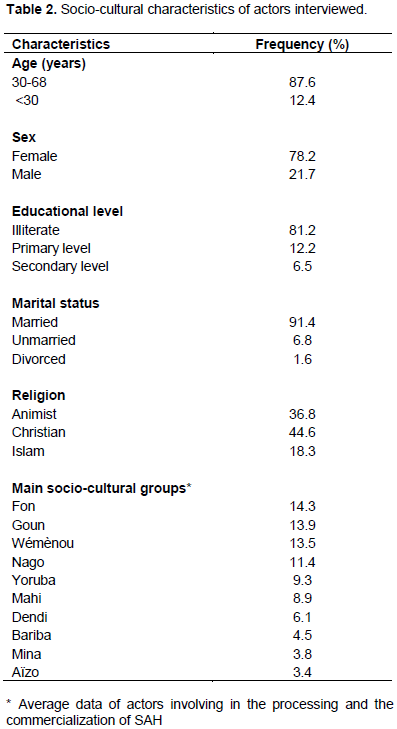
Regarding the processors, the majority of them (80%) were women. These results are consonant with those of Kindossi et al. (2012) about Lanhouin, a fermented fish condiment used as taste enhancer and flavouring agent in many dishes in Benin. Men were also involved in the processing of SAH but they represented only 20% of processors surveyed. Among the processors, the adults and the young represented 91.3 and 7.3% respectively, and 1.3% of adults were more than 60 years old. Three categories of processors were identified: the small scale processors (87%) processed less than 200 kg/month, the medium-scale processors (2%) processed between 200 and 400 kg/month and the large scale processors (11%) processed between 400 and 1000 kg/month (Table 3).

Many socio-cultural groups were also involved in the processing of SAH but the main ones were: Wémènou (15.6%), Fon (14.6%), Nago (11.3%) Goun (10.6%) and Mahi (10%) (Table 2). The study also showed that the consumers of SAH belonged to all socio-cultural groups and fairly distributed between men and women.
Spices and aromatic herbs identified and their frequency of consumption
The survey showed that many spices and herbs were used by people interviewed (Table 4). Similar list has been reported by Pouillart and Pouillart (2013) and Codex (2015). Some of these spices and aromatic herbs were used alone, but several of them were also mixed within the group of spices or with aromatic herbs for culinary uses (Table 5). The frequency of consumption of spices and aromatic herbs varied according to the respondents and from one spice to another. Thus, chili (claimed by 14.0%), ginger (13.6%), garlic (12.9%), pepper (11.8%), onion (10.4%), anise (10.3%), sweet pepper (8.5%), nutmeg (8.3%), clove (6.5%), and Guinea pepper (6.4%) were the more spices consumed by the respondents (Figure 1a), while laurel ( 43.8%) and basil (38.3%) were the most aromatic herbs used (Figure 1b). Data also showed that mint, celery, Gambia tea, and rosemary were the less aromatic herbs used, while thyme, dill, cumin, cinnamon and star anise were the less spices consumed.
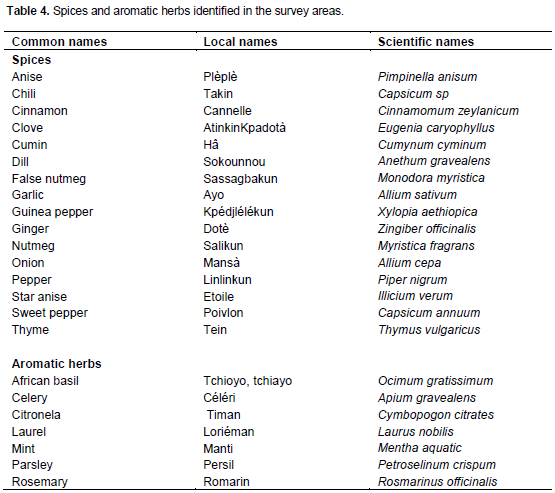
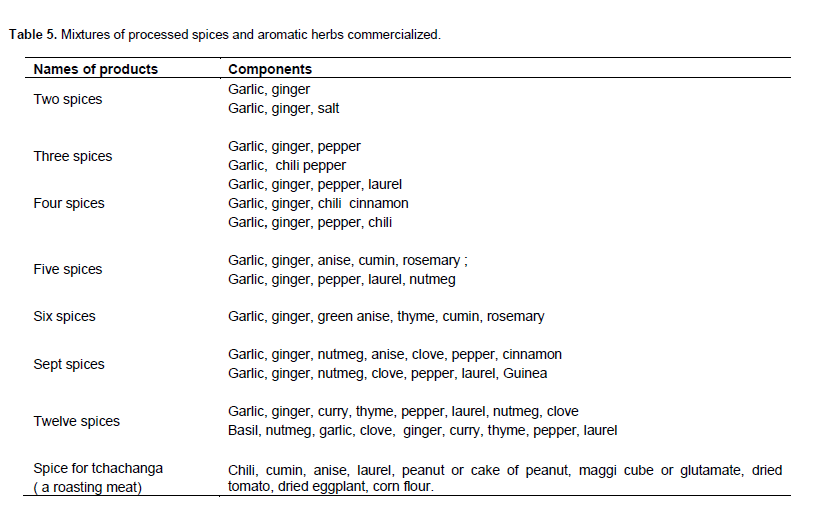

Processing of spices and aromatic herbs and difficulties claimed by respondents
The processing of SAH varied according to the type of spices and the areas investigated. The processing steps are summarized through the Figure 2. The main steps included the following.
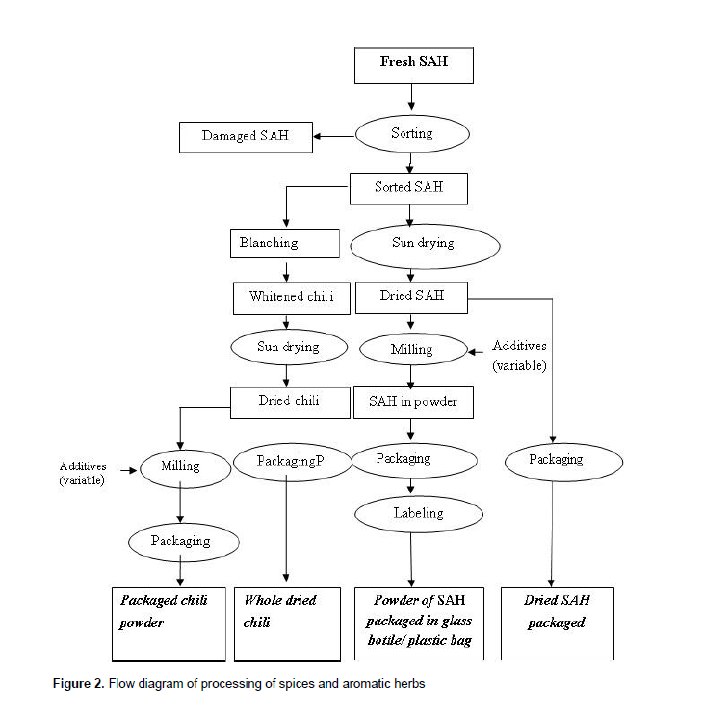
Sorting and heating
Sorting is the first step of the processing of SAH. During this step, the SAH are sorted to remove the undesirable parts (rotting or mouldy parts). Regarding the heating, which is mainly applied in the case of chili, 2 L of water is added to 25 kg of product and the mixture is heated at 80 to 90°C during an average time of 5 min before being sun dried. During the heating step, palm oil (1/2 L for 25 kg of chili) is added to the hot water (practiced by 18% of processors) in order to improve the organoleptic characteristics of the sun died product.
Sun drying of SAH
The sun drying is one of the most important steps of the processing of the SAH as reported by Dufresne (2008). According to Bonazzi and Dumoulin (2014), the sun drying technique reduces the water activity in the SAH, and consequently prevents the development of microorganisms, but it also reduces the weight of SAH and unfavourably output after drying (claimed by 98% of processors interviewed). Similar observations have been reported by Dufresne (2008). Unfortunately, the drying technique applied by the processors remained even traditional (98% of surveyed processors) because limited to the sun drying as reported by Tunde-Akintunde (2010) while only 1.2% of them use the electric dryer. The SAH are dried either on the ground (13.4% of processors) concerning the aromatic herbs such as Citronella (Cymbopogon citratus) and Laurel (Laurus nobilus), even on the floorbord (27.2% of processors), on jute bags (17.1% of processors), on the flat baskets (12.1%) of processors) and on the sidewalks (29.3% of processors).
In contrast to the sun drying practices of SAH in Africa, drying using modern driers in developed countries limits the risks of contamination. Another problem resulting from the sun drying is that it is not possible to determine the drying time as the sun intensity is variable. Consequently, the duration of sun drying can influence the active compounds, the colour or the burst of spices and aromatic herbs (Peter, 2006). In addition to this, the drying on the sidewalks and on the ground can lead both to chemical and microbiological contamination of foods making them inappropriate for consumption (Salari et al., 2012). In fact, this method of drying can also be a source of contamination by heavy metals, pathogenic micro-organisms or spore of pathogenic organisms, and physical agents such as twig or stone (Mediss, 2012). Similar observations were also reported by Peter (2006) who revealed various types of micro-organisms infestation during the sun drying of spices and medicinal plants.
Milling of SAH
The sun drying of SAH is followed by the milling step as reported by Hossain (2010). Various traditional milling methods were noticed during the survey. They are: use of cemented millstone (68.3%), built stone (11.4%) and mortars (2.5%). Different modern mills were also used by the processors interviewed: small mill (8.9%), plate disc mill for corn (58.2%) and plate disc mill for condiments (39.4%). The mills are often installed in unhygienic places (33%). According to Sung et al. (2012), the milling operation can lead to the loss of flavour of spices and aromatic herbs. This was mentioned by 14.55% of processors interviewed. Furthermore, the plate disc mills may be contaminated by other matter because the mill is used to grind other types of products such as leguminous, piece of dried yam, etc. Therefore, the type of milling can negatively impact the microbial status of ground spices and aromatic herbs and the colour as well.
Packaging of SAH
The ground spices obtained are packaged in different types of materials such as glass bottles (64.6%) or in small plastic bottles (6%) while jute bags (19.3%), plastic bag (6.7% and baskets or bowls (3.3%) are used as packaging materials for non-ground spices. From these results, it appeared that glass bottle is the packaging material mostly used by the processors of spices. According to the processors interviewed, the glass bottles allowed a good presentation of the product and long conservation period as well. These results are in accordance with the findings of various authors who reported the use of various package materials, sometimes conventional like paperboard boxes, multi-wall paper bags, plastic sacks that conferred to the spices and aromatic herbs a better conservation (Prashant, 2014).
According to the processors interviewed, various constraints were associated with the processing of spices and aromatic herbs. The most cited by these actors were: the sun drying practice, because of its duration and the climatic risks (80%), the milling (70%) because of the irritating characters of spices. Concerning the chili, the heating applied before the sun drying was also mentioned as a constraint (18%) because they need to watch the fire to avoid the over cooking of the product.
Storage of spices and aromatic herbs and problems associated with the storage
After processing, the SHA were immediately sold or stored by using various techniques. For 75% of processors interviewed, the non-processed SAH are sun dried twice or three times a week for long period conservation (two years) or dried with electric drier (1.2%) to avoid the attack by mould. The storage of fresh SAH (chili, ginger, anion, and garlic) by the cool is practiced by 5% of the processors. The maximum storage duration of the SAH kept in cool conditions is 10 days according to 80% of the processors who practiced this technique. Thus, the moisture level for most spices and aromatic herbs should be reduced to below 11% in order to prevent the proliferation of microorganisms. According to the European Spice Association, the moisture content in spices after drying is very decisive for the microbial proliferation (Yogendrarajah, 2014; Tulu et al., 2014). For 98% of processors, the salt added to SAH during the milling allowed to keep them at least for one year. But, the SAH in powder already lost after 3 months some of their organoleptic characteristics such as the taste revealed by 11.4% of the respondents and 9.9% for the aroma.
In summary, the duration of the storage of spices is a function of the storage methods used (refrigeration, drying, packaging). From the survey data, it appeared that the products that did not last longer in storage were those stored with the cool (that is, at most 7 days for chili). In contrast, the dried products last longer and can be stored during two years as mentioned by 86% of the processors. The survey also showed that the major storage problems faced by the processors were the rotting of fresh SAH (cited by 65.3% of the respondents), the attack by mould related to the no ground dried products pointed out by 63.3% and powder products mentioned by 26% of the interviewees. The presence of dead maggots (38.2%) of processors, the loss of weight (18.1%) and aroma (9.98%) during the storage were also reported for dried products in general and the ground ones in particular. In addition, the attack by mould during the storage period can lead to the production of aflatoxins as reported by Set and Erkmen (2010). Other majors problems observed were the general unhygienic conditions of the processing sites and the processing material leading to the contamination of the product.
Quality attributes of SAH
All the respondents (processors, consumers, traders) interviewed based their choice on quality criteria including: the physical integrity of the SAH (absence of rotting or mouldy parts) (48.4%), the absence of foreign elements (57.3%) and the aroma, that is, the most important quality attribute (45.5%) (Table 6).

However, some of the processing practices mentioned earlier can affect the quality criteria. In fact, during the drying step, about 13.4% of the processors spread their products on the floor, while 29.3% spread them on the sidewalks contrary to hygiene related to dried spices and aromatic plants (Codex, 2015) that recommends a drying on platforms built with suitable materials. In the same time, the drying on the sidewalks or the floor does not guarantee the protection of the spices against contamination by house animals, rodents, birds, bugs, arthropods, and microorganisms as well. Similar results have been reported by Romagnoli et al. (2007) who noted the presence of Aspergillus species, Penicillium species and Fusarium species in various food products including spices and aromatic herbs. In this respect, the sun drying of SAH mainly practiced by the majority (98%) of processors and traders could increase the risks of attack of SAH by the mould during the rainy season.
Indeed, according to Nguyen et al. (2007), the rate of growth of Aspergillus parasiticus in SAH samples increased to 60% in the rainy season. These findings showed that there is a relationship between the moisture content in SAH after the drying and the proliferation of moulds or other microorganisms (Iqbal et al., 2011).
Consumption and forms of use of the SAH
In the markets, the consumers bought the SAH in fresh form, as powder obtained from one or a mixture of several SAH. Several reasons explain the use of the SAH by the consumers. They are mainly used as taste and aroma enhancer: chili, garlic, onion, ginger, clove, pepper, thyme, dill, cumin, anise, nutmeg, cinnamon and laurel (68.5% of the respondents), for medicinal reasons: basil, clove, onion, garlic and ginger (46.5%), against snakes: chili, guinea pepper (43.8%), for cosmetic use: mint, chili (41.1%), as preservative: chili for various cereals (maize, sorghum) and bean (39.5%), for spiritual reason: mint, clove, pepper of Guinea, false nutmeg, basil, tea of Gambia (39.2%) and as aphrodisiac product: ginger (2%). The SAH were usually incorporated in several types of dishes including: sauces (89%) (tomato sauce, vegetable sauce, groundnut or egoussi sauce, and sauce dja which is a fried tomato sauce), pasta products (49.%), uncooked tomato sauce called monyo (37.4%), beverage (21.5%) (syrup of ginger, mint and garlic) and salad (20.3%) (Figure 3). These dishes are consumed at breakfast, lunch and dinner, and at various places including home, street food, restaurant, and funeral ceremonies (Table 7).
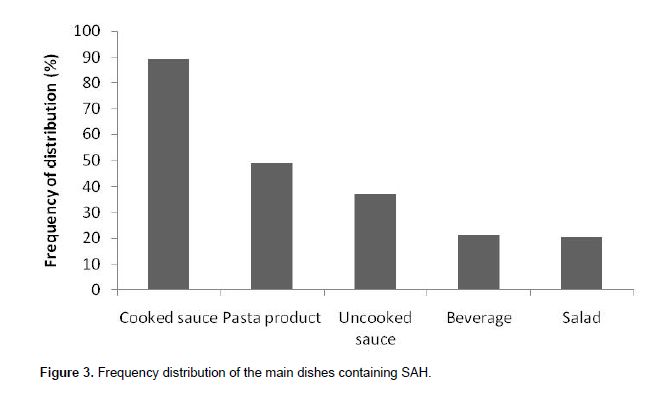

Relationship between socio-cultural groups and types of SAH
The principal component analysis (PCA) performed on various spices and aromatic herbs, and social-cultural groups resulted in two axes accounting for 62.01% of the total variation, of which 32.71% was explained by the first axis (Axis 1) and 29.3% by the second (Axis 2) (Figure 4). Spices and aromatic herbs consumed by particular socio-cultural groups were grouped together with the groups. Considering Axis1, the Adja, Bariba, Dendi, Ditamari, Goun, Natimba, Yoruba, Mahi, and Nago groups mainly used African basil, anise, chilli, pepper, cumin, false nutmeg, garlic, ginger, laurel, guinea pepper, nutmeg, onion, rosemary and sweet pepper. With respect to Axis 2, celery, cinnamon, pepper, and thyme are more consumed by the Aizo, Fon, Haoussa, Djoula (Malian), Mina and Wémènou.